Building a dog house can be a fun and rewarding project that gives your pup a cozy spot to call home. With just a few materials and some simple steps, you’ll create a space where your dog can relax, stay safe, and escape the elements. Let’s jump into the essentials you need to get started on your DIY dog house!
Adding Ventilation for Fresh Air

When building a dog house, fresh air is key. A well-ventilated space keeps your pup comfortable and healthy. In the image, you can see a cute dog peeking out from a cozy dog house. Notice the vents at the top? They play a big role in airflow.
Proper ventilation helps reduce humidity and prevents overheating. If your dog house is too stuffy, it can lead to discomfort. Adding vents allows hot air to escape while letting cooler air in. This simple step can make a huge difference.
Consider placing vents on opposite sides of the house. This creates a cross-breeze, ensuring air flows freely. You can also use mesh screens to keep bugs out while allowing air in. Your dog will appreciate the fresh air, especially on warm days!
Creating an Elevated Dog House
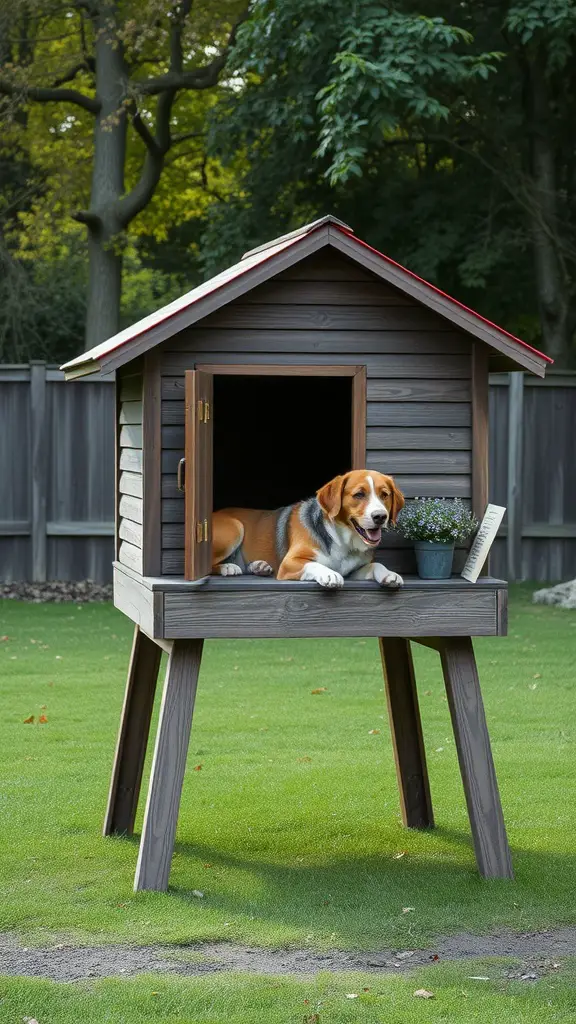
Building an elevated dog house is a fun project that benefits both you and your pup. The image shows a charming dog house with a slanted roof and a cozy entrance. This design keeps your dog off the ground, providing comfort and protection from the elements.
The elevated structure helps with ventilation, keeping your dog cool in the summer. It also prevents moisture from seeping in, which is great for their health. The wooden design blends nicely with the outdoor setting, making it a stylish addition to your yard.
Adding personal touches, like a flower pot or a small sign, can make the house feel special. Your dog will love having their own space to relax and watch the world go by. Plus, it’s a great way to show your love and care for your furry friend!
Designing the Perfect Size for Your Dog

When creating a dog house, size matters. You want your pup to feel cozy and secure. The image shows a simple dog house with a few playful dogs around it. This visual reminds us that measuring is key.
Start by measuring your dog from nose to tail and add a few inches for comfort. The height of the house should allow your dog to stand up without bumping their head. A good rule of thumb is to make the house about 25% taller than your dog.
Width is just as important. Your dog should be able to turn around easily inside. If you have multiple dogs, consider their sizes and how they might share the space. The image highlights different dog sizes, which is a great reminder to customize based on your pet’s needs.
Lastly, think about the location of the house. It should be in a safe, shaded area away from harsh weather. With the right size and placement, your dog will have a perfect little retreat!
Choosing the Right Materials for Your Dog House

Building a dog house is a fun project that can provide a cozy spot for your pup. The materials you choose play a big role in how comfortable and durable the house will be.
In the image, you can see various pieces of wood laid out, ready to be assembled. Using quality wood is key. Cedar and pine are popular choices. They are sturdy and can withstand the elements.
Make sure to avoid treated wood, as it can contain chemicals harmful to pets. Look for untreated, natural wood that is safe and non-toxic.
Also, consider insulation. A well-insulated dog house will keep your pet warm in winter and cool in summer. You might want to add some foam board or straw for extra comfort.
Finally, think about the roof. A sloped roof helps with rain runoff, keeping the inside dry. You can use shingles or metal for added protection. With the right materials, your dog house will be a perfect retreat for your furry friend!
Choosing a Roof Style for Weather Resistance
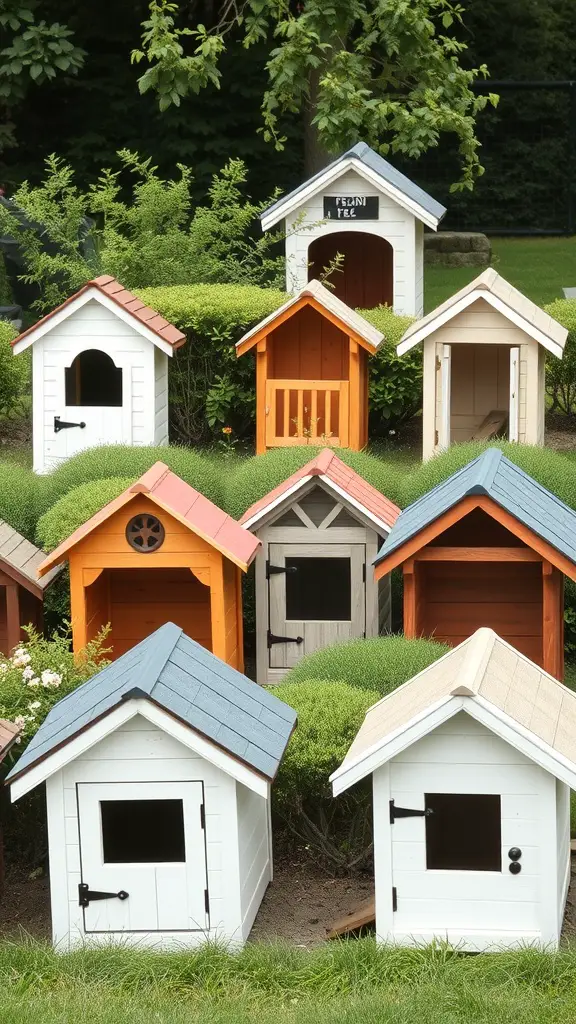
When building a dog house, the roof style plays a big role in keeping your pup safe and dry. The image shows a variety of dog houses, each with different roof designs. Some have sloped roofs, while others are flat or gabled. Each style has its own benefits.
A sloped roof is great for shedding rain and snow. It helps prevent water from pooling, which can lead to leaks. On the other hand, a flat roof might be easier to build but can collect water if not properly sloped. Consider your local weather when choosing a roof style.
Another thing to think about is insulation. A well-insulated roof can keep your dog warm in winter and cool in summer. Adding materials like foam or reflective panels can enhance comfort. Look at the roofs in the image; some have shingles, while others use metal or tiles. Each material has its own advantages regarding durability and insulation.
Lastly, don’t forget about aesthetics! A roof that matches your home can create a cohesive look. Whether you prefer bright colors or natural wood finishes, there’s a style for every taste. Take your time to choose a roof that’s not just functional but also fits your style.
Incorporating a Porch or Deck

Adding a porch or deck to your dog house can create a cozy spot for your pet to relax. This little area can serve as a great transition space between the outdoors and the comfort of their home. Imagine your dog lounging on a mat, soaking up the sun while keeping an eye on the yard.
In the image, you can see a charming dog house with a lovely porch. The porch is not just functional; it adds a touch of style. Potted plants around the entrance enhance the look, making it inviting. This setup allows your dog to enjoy fresh air while being sheltered from the elements.
When planning your porch, think about the size. It should be spacious enough for your dog to move around comfortably. A small mat can provide a soft spot for them to sit or lie down. You might also want to add some decorations, like flowers or a welcome sign, to make it feel like home.
Consider the materials you use for the porch. Wood is a popular choice, but make sure it’s treated to withstand the weather. You can also add a railing for safety, especially if your dog is a bit rambunctious. A well-built porch can be a great addition to your dog house, giving your pet a special place to enjoy the outdoors.
Insulation Techniques for Year-Round Comfort

Creating a cozy dog house is all about keeping your pup comfortable in every season. The image shows a well-built dog house with insulation techniques that can make a big difference. The roof is topped with snow, indicating a chilly environment, but the interior looks warm and inviting.
One effective method is using foam insulation boards in the walls and roof. This helps keep the heat in during winter and the cool air in during summer. You can also line the interior with blankets or dog beds, which adds extra warmth.
Another tip is to elevate the dog house off the ground. This prevents cold and moisture from seeping in. A raised platform allows for better airflow, keeping the space dry and comfortable.
Don’t forget about the entrance! A flap or curtain can help block wind and keep the warmth inside. It’s a simple addition that makes a big impact.
With these insulation techniques, your dog will have a snug retreat no matter the weather. It’s all about creating a safe and comfy space for your furry friend.
Building a Dog House with Recycled Materials
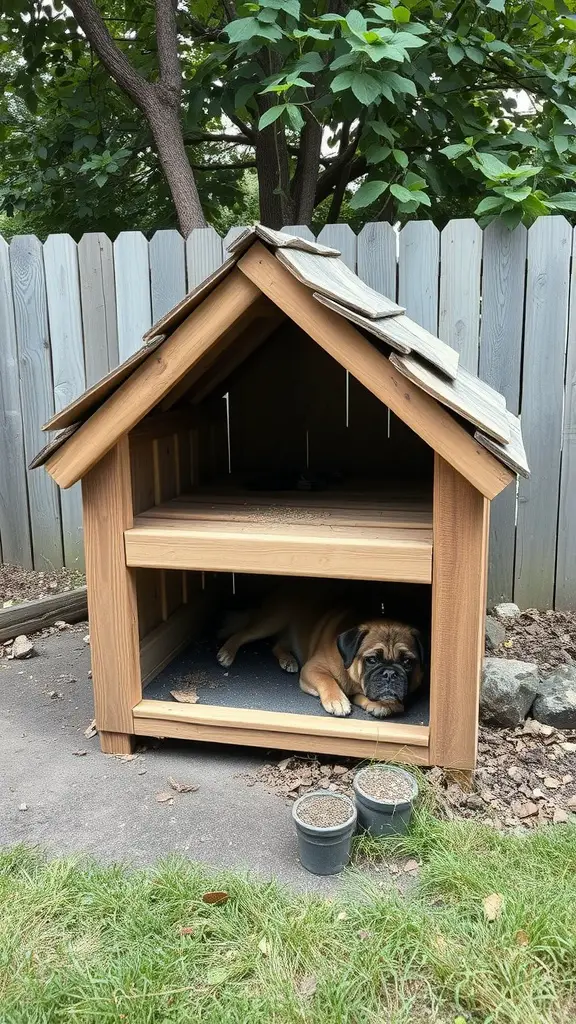
Creating a dog house from recycled materials is a fantastic way to give your pet a cozy spot while being kind to the environment. The image shows a charming wooden dog house, complete with a slanted roof and a spacious interior. It looks sturdy and inviting, perfect for any dog looking for a safe retreat.
Using recycled wood not only saves money but also adds character to the dog house. You can often find old pallets or scrap wood that can be repurposed. The natural look of the wood blends beautifully with the surrounding greenery, making it a lovely addition to any backyard.
In the photo, a dog is comfortably resting inside the house, showcasing how inviting it is. This design features two levels, providing ample space for your furry friend. Adding some soft bedding inside can make it even more welcoming.
Don’t forget to include a few personal touches, like a nameplate or some decorations. This will make the dog house feel like home for your pet. Plus, it’s a fun project that can involve the whole family!
Creating a Cozy Interior with Bedding
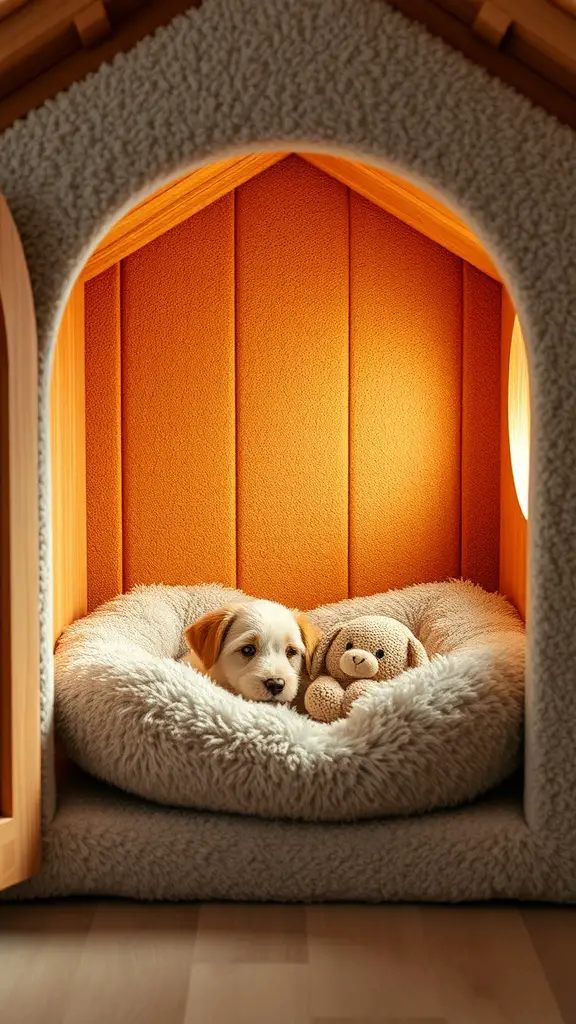
When it comes to making your dog house feel like home, bedding is key. A soft, inviting bed can turn a simple space into a cozy retreat. In the image, you can see a fluffy bed that cradles a puppy, making it the perfect spot for naps and relaxation.
Choosing the right bedding is important. Look for materials that are comfortable and easy to clean. The bed in the picture has a plush texture that offers warmth and comfort. Adding a favorite toy, like the teddy bear seen here, can also make the space feel more personal and inviting.
Don’t forget about color! The warm orange walls create a cheerful vibe, while the soft bedding complements it nicely. You can mix and match colors to suit your style and your dog’s personality. A cozy interior not only keeps your pet happy but also makes the dog house a lovely addition to your yard.
Decorative Paint Ideas for Personalization

Personalizing your dog house can be a fun and creative project. The image shows a bright and cheerful dog house, painted in a lovely blue with a red roof. The colorful flowers, sun, and playful designs make it stand out in any yard.
Using vibrant colors like yellow and red can bring a joyful vibe. You can add your dog’s name or fun shapes like hearts and stars. This not only makes the house unique but also reflects your dog’s personality.
Consider using non-toxic paint to keep your pet safe. Stencils can help create clean designs, making it easier to add details. You can even involve your kids in the painting process for a family activity!
Lastly, don’t forget to add some plants around the dog house. They can enhance the overall look and create a cozy spot for your furry friend.
Designing for Easy Cleaning and Maintenance
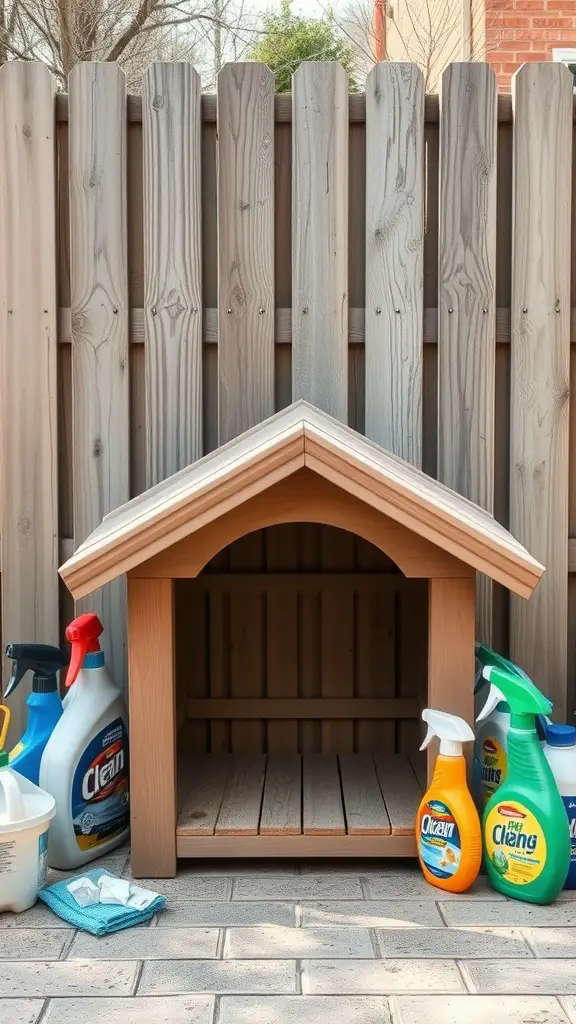
When building a dog house, keeping it clean is key. The image shows a freshly built dog house with cleaning supplies neatly arranged around it. This setup makes it clear that maintenance is a priority.
Start by choosing materials that are easy to wipe down. Smooth surfaces can save time and effort when cleaning up after your pup. The dog house in the image looks like it has a simple design, which is great for quick clean-ups.
Consider adding a removable floor or a washable mat inside. This makes it easier to keep the space tidy. The cleaning products around the dog house suggest that regular upkeep is part of the plan. Having the right tools on hand makes the job simpler.
Lastly, think about the location of the dog house. Placing it in a spot that’s easy to access will make cleaning less of a chore. With these tips, you can create a comfortable space for your dog that’s also easy to maintain.
Incorporating Safety Features into Your Design

When building a dog house, safety should be a top priority. The image shows a charming wooden dog house that looks both cozy and secure. It’s important to ensure that your design protects your pet from the elements and potential hazards.
First, consider the materials you use. The wooden structure in the image is sturdy and can withstand various weather conditions. Make sure to choose non-toxic finishes to keep your dog safe. Ventilation is also key; the design should allow for airflow to keep your pet comfortable.
Another aspect is the entrance. A well-fitted door, like the one shown, helps keep out rain and wind. You might also want to add a flap or a cover to shield your dog from harsh weather. Ensure there are no sharp edges or splinters that could harm your furry friend.
Lastly, think about the location of the dog house. It should be placed in a shaded area to protect your pet from overheating. Keeping these safety features in mind will help create a safe and welcoming space for your dog.
Choosing the Right Location for Placement
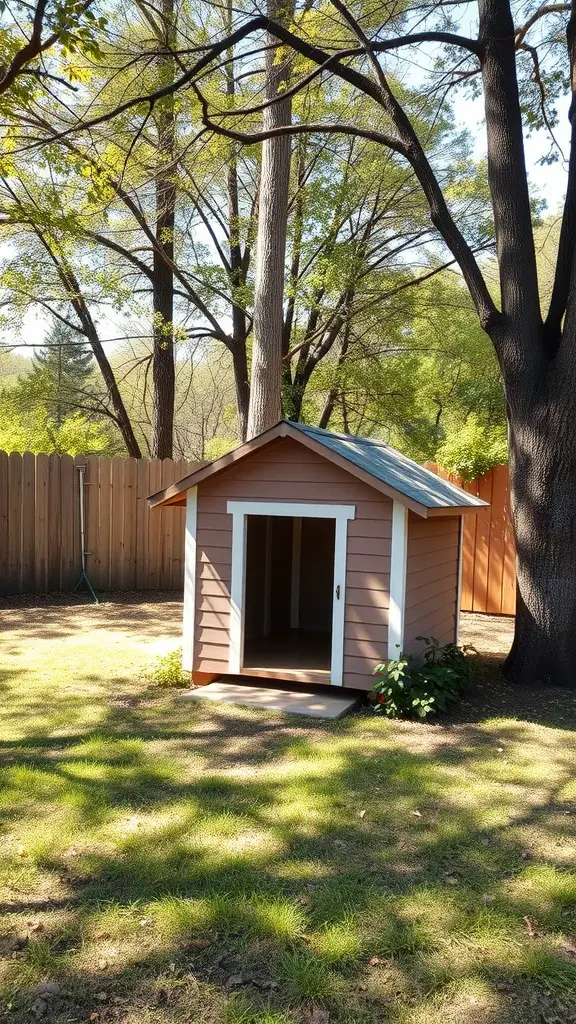
When setting up a dog house, location is key. The right spot can make your pup feel safe and comfortable. Look for a place that offers some shade, especially during hot days. Trees or tall shrubs can provide a natural barrier against the sun.
Consider the ground too. A flat, dry area is ideal. This helps keep the dog house stable and prevents water from pooling around it during rain. The image shows a lovely dog house positioned in a grassy area with trees nearby, which is a great example of a balanced location.
Also, think about accessibility. Your dog should be able to enter and exit easily. Avoid placing the house too close to fences or other obstacles. A little space around the house allows your dog to roam freely and enjoy the outdoors.
Lastly, keep in mind the proximity to your home. It’s nice to have the dog house within sight so you can keep an eye on your furry friend while they relax outside.
Adding a Dog Run Attached to the House
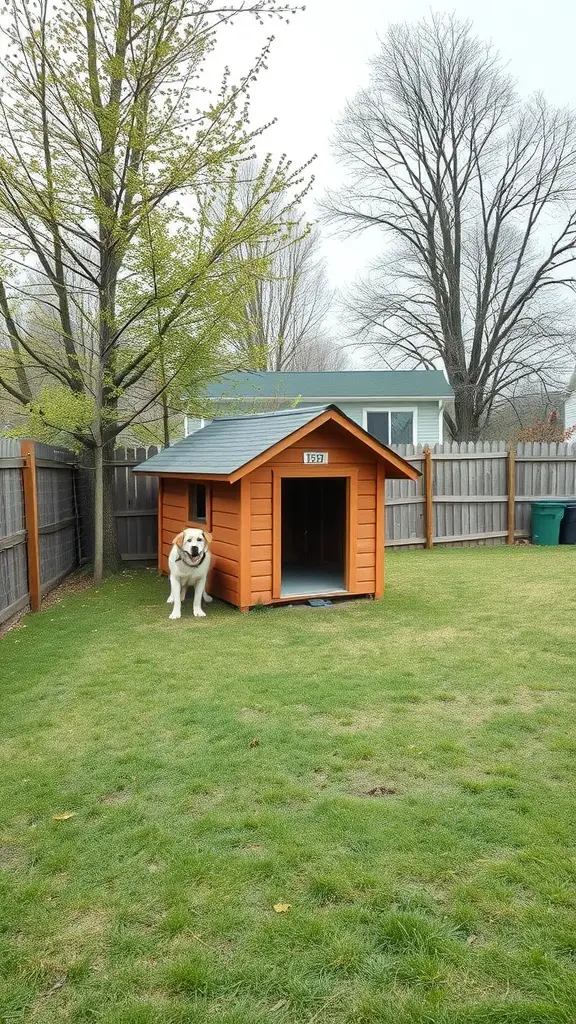
Creating a dog run attached to your dog house can be a great way to give your pup some extra space to roam. This setup allows your furry friend to enjoy the outdoors while staying safe and secure. In the image, you can see a charming dog house, perfectly positioned in a grassy area, ready for your dog to explore.
When planning your dog run, consider the size and layout. You want enough room for your dog to play and stretch out. A simple fence can create a safe boundary. Make sure it’s tall enough to prevent any escapes. The dog house in the picture looks inviting, and it’s a perfect spot for your dog to rest after some fun.
Don’t forget about comfort! Adding some shade or a cozy spot inside the dog house can make it a favorite hangout. You can also include toys or a water bowl in the run area. This will keep your dog entertained and hydrated while they enjoy their time outside.
Lastly, think about maintenance. Regularly check the area for any hazards and keep it clean. A well-maintained dog run will ensure your pet stays happy and healthy. With a little effort, you can create a wonderful space for your dog to enjoy.
Incorporating Fun Accessories for Your Dog
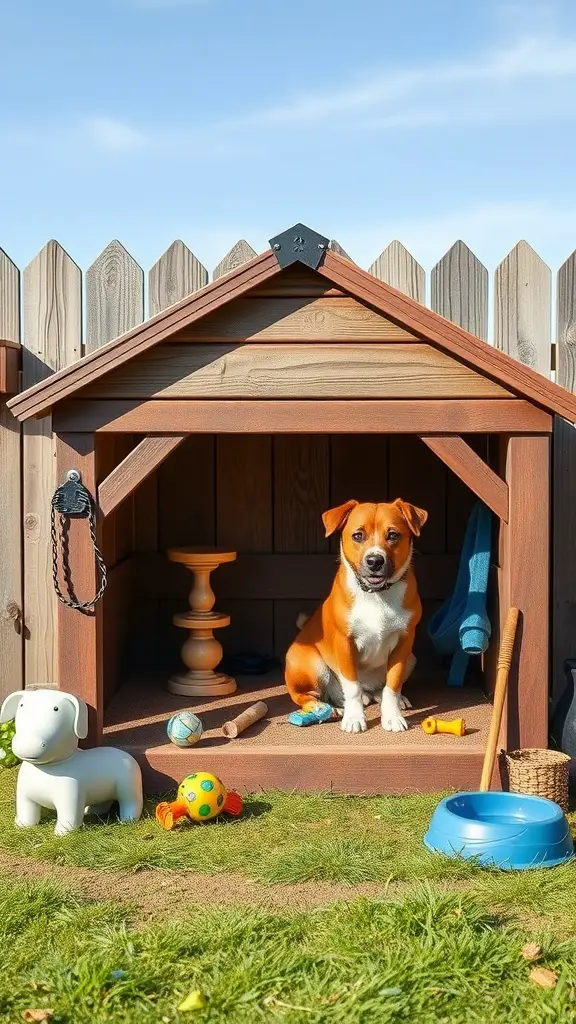
Creating a cozy dog house is just the start. Adding fun accessories can make your pup’s space even more inviting. In the image, we see a charming dog house with a happy dog sitting inside, surrounded by colorful toys and a water bowl.
Consider including a variety of toys to keep your dog entertained. The image shows a mix of balls, chew toys, and even a cute dog figurine. These items not only provide fun but also help with your dog’s mental stimulation.
Don’t forget about comfort! A soft blanket or a cozy bed can make the dog house feel like a true home. The dog in the picture looks content, which shows how important a comfortable space is for our furry friends.
Finally, think about practical accessories. A water bowl, like the blue one in the image, is essential for keeping your dog hydrated. You can also add a feeding station nearby for convenience. With these thoughtful touches, your dog’s house will be a perfect retreat.
Building a Multi-Dog House
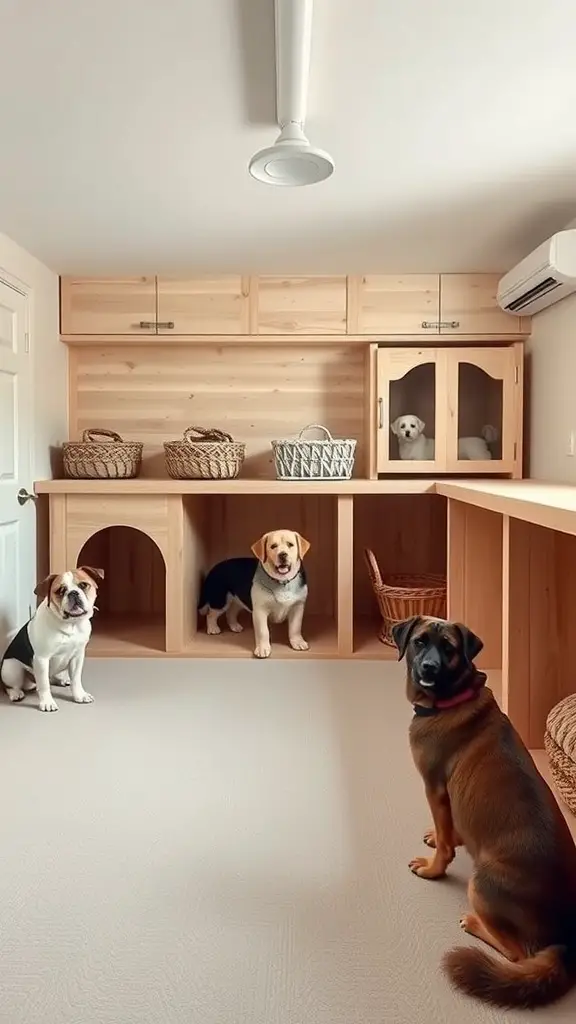
Creating a multi-dog house is a fun project that can bring comfort to your furry companions. The image shows a cozy space designed for multiple dogs, featuring wooden structures and cozy corners. Each dog has its own little nook, making it a perfect retreat.
Start by measuring the space you have available. You want to ensure that each dog has enough room to move around comfortably. Use sturdy materials like wood for the structure. The natural look blends well with any home decor.
Consider adding shelves or cubbies for toys and blankets. This keeps everything organized and gives your dogs a place to snuggle up. The baskets seen in the image are a great way to store their favorite items.
Don’t forget ventilation! Proper airflow is key to keeping the space fresh. You can add windows or vents to ensure your dogs stay cool in warmer months.
Lastly, make it personal. Add their names or favorite colors to the design. This makes the space feel like home, and your dogs will love it!
Creating a Themed Dog House
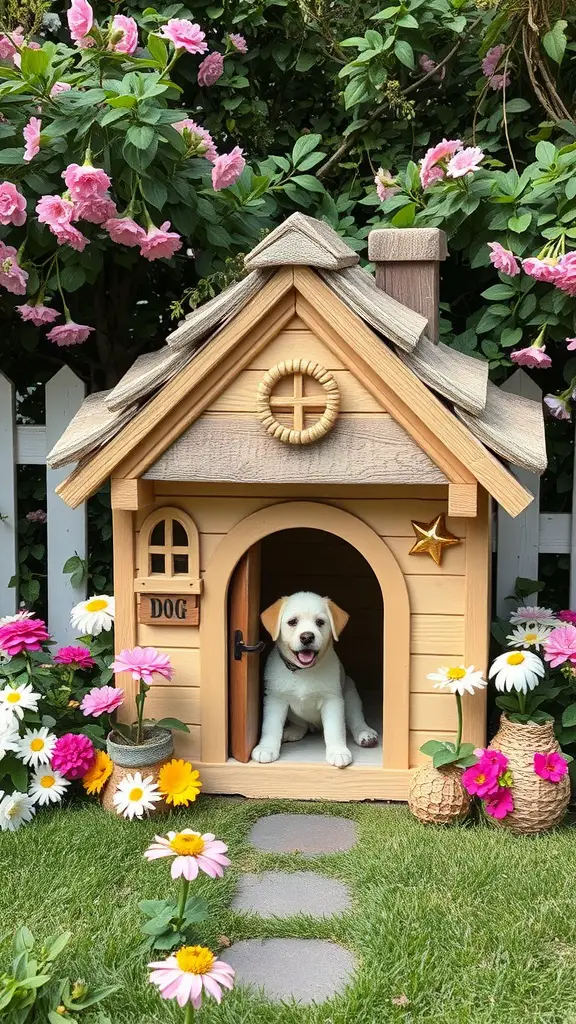
Building a themed dog house can be a fun project that adds charm to your yard. The image shows a delightful dog house surrounded by colorful flowers. This setup not only looks inviting but also creates a cozy space for your pup.
The dog house features a classic design with a wooden exterior and a cute little door. The star decoration adds a playful touch, making it feel special. You can easily customize your dog house with colors and decorations that match your home or garden.
Consider adding some fun elements like a nameplate or themed decorations that reflect your dog’s personality. Surrounding the house with flowers, as shown, makes it feel like a little paradise. It’s a great way to create a welcoming spot for your furry friend.
Using Technology for Monitoring Your Dog

In today’s world, keeping an eye on our pets has become easier with technology. The image shows a cozy dog house equipped with a camera and monitoring devices. This setup allows pet owners to check in on their dogs from anywhere.
Having a camera on your dog house means you can see what your pup is up to while you’re away. This is especially helpful for those who worry about their pets when they are not at home. You can watch them play, rest, or even bark at passing squirrels!
Moreover, some devices can send alerts to your phone if your dog is barking excessively or if there are any unusual activities. This way, you can respond quickly if something seems off. It’s a great way to ensure your dog is safe and happy.
Setting up these technologies can be part of your DIY dog house project. It adds a modern touch to a traditional dog house, making it not just a shelter but also a smart space for your furry friend.
Adding Lighting for Nighttime Use

When it comes to making your dog’s house cozy, adding lighting can make a big difference. The image shows a charming dog house lit up with warm lights, creating a welcoming atmosphere. This setup not only looks great but also ensures your furry friend feels safe and secure at night.
String lights are a fantastic option. They can be easily draped around the dog house, adding a touch of magic. You can choose solar-powered lights for an eco-friendly choice. These lights charge during the day and automatically turn on at night, saving you the hassle of wiring.
Another idea is to install a small LED light inside the dog house. This provides a soft glow that helps your pet find their way in the dark. Make sure the light is safe and doesn’t get too hot. You want your pup to enjoy their space without any worries.
Don’t forget about the placement of the lights. Position them to highlight the dog house without being too bright. The goal is to create a cozy nook that feels inviting. With the right lighting, your dog house can be a charming retreat for your pet, even after the sun goes down.
Planning for Seasonal Changes in Design

When building a dog house, it’s key to think about how the seasons will affect your design. The image shows a cozy wooden dog house, perfect for keeping your pup warm in winter. The sloped roof helps snow slide off, preventing buildup that could weigh it down.
In colder months, insulation is vital. Consider using materials that keep the heat in, like thick wood or adding straw inside. Ventilation is also important to prevent moisture buildup, which can lead to mold.
As the weather warms up, you might want to add features like shade or a cooling area. A dog house with a raised floor can help keep your pet cool by allowing air to circulate underneath. Think about adding a removable roof or door that can be opened for airflow during hot days.
Overall, planning for seasonal changes means creating a space that is comfortable year-round. Your dog will appreciate a well-thought-out home that meets their needs, no matter the weather!
Customizing the Entrance for Easy Access
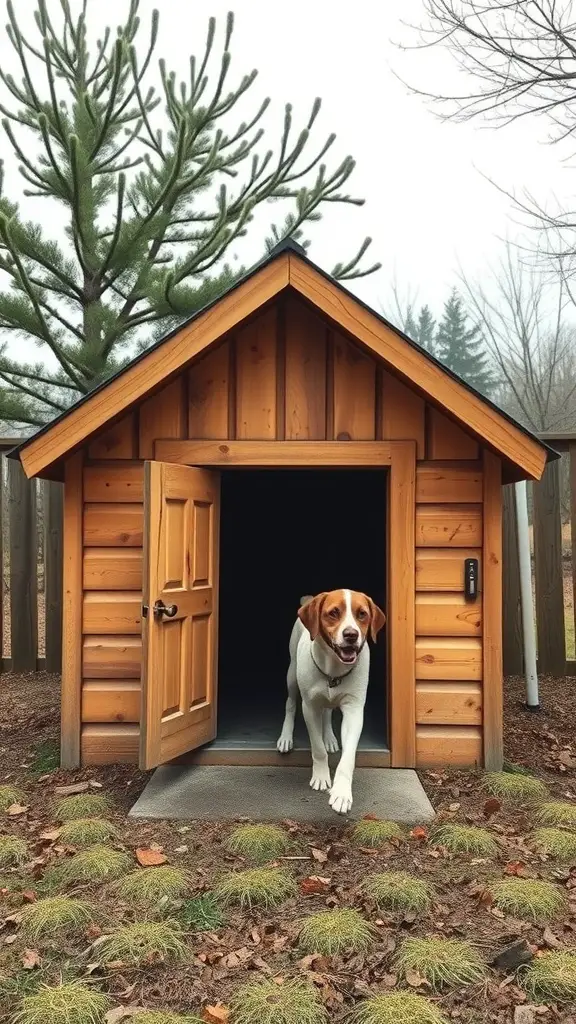
When building a dog house, the entrance is key. A well-designed door makes it easy for your pup to come and go. In the image, you can see a charming wooden dog house with a spacious entrance. This setup allows for plenty of room, so your dog can enter without any fuss.
Consider the height and width of the door. It should be just right for your dog’s size. If it’s too small, your dog might hesitate to go inside. If it’s too big, it may not feel cozy. The door in the picture strikes a nice balance, providing comfort and accessibility.
Adding a small ramp can also help, especially for older dogs or those with mobility issues. This makes the entrance even more inviting. A smooth, flat surface at the threshold, like the one shown, can prevent tripping and make it easier for your dog to step in and out.
Finally, think about the door style. A simple flap or a hinged door can work well. The door in this image is hinged, which is practical and adds a nice touch to the overall look. Whatever you choose, make sure it’s easy for your dog to use!

Hi, I’m Ali Tarek, the founder of Animalsman. I’ve always been passionate about pets, especially dogs and cats, and I created this website to share practical tips, easy recipes, and helpful care advice for fellow pet lovers. My goal is to make pet care simple, enjoyable, and accessible for everyone. When I’m not writing or curating content, you’ll usually find me spending time with my furry friends or learning new ways to keep them happy and healthy.


